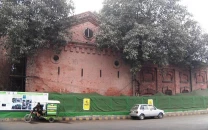Exhibition: Artisan hopes to keep woodwork tradition alive
Muhammad Waseem displays fine lacquer work on wood.

Waseem and other preparing some pieces while finished products are also pictured. PHOTO: MYRA IQBAL/EXPRESS
In an effort to keep a 450-year-old artistic tradition alive, Mohammad Waseem, an artisan from Dera Ismail Khan, is displaying unique lacquer work on wood at the Serena Bazaar Court for a three-day exhibition which started here on Wednesday evening.
A small stall at the Serena Court yard with a display of collection of various items catches the attention of passersby. With small spotlights installed that make the items glow in the otherwise dark space, Waseem, with an optimistic attitude hopes to grasp attention of not just art lovers but other organisations that would help him keep the tradition alive.
Waseem learned the craft from his father, Mohammad Ashraf, who was awarded a Pride of Performance by the Government of Pakistan. Waseem traces his lineage to Ustad Karim Ali, a famous artist in the court of the Mughal Emperor Shah Jehan. Waseem’s great-great grandfather left Delhi during the violence of 1857 to settle in Dera Isamil Khan, where Waseem now lives and works.
While tracing the skill back to his roots, Waseem said that the art style started from Iran, travelled to Delhi, and eventually ended up in Dera Ismail Khan. The style requires days of work. Strenuous procedure and intricate colour work is needed to make the finished product. First refined and seasoned wood is dipped in rainwater, then left to dry for a day, the dried wood is painted in three shades --- yellow, red and black. Next, a traditional pattern is painted on the base. A small piece can be made in a day, but larger pieces take between 8 and 10 days, Waseem explained. The cost of production is between Rs200 and Rs250 per piece.

Waseem and other preparing some pieces while finished products are also pictured. PHOTO: MYRA IQBAL/EXPRESS
Waseem has been practicing the art for more than three decades and hopes to keep the art alive past his own life. “I would want this art to live through upcoming generations,” He said. Training his eight-year-old daughter, He anxiously waits for the time his two sons are old enough to learn the skill as well. “I am not teaching them so that they just learn a skill, I want them to carry on the legacy by teaching their children,” He said with a smile.
His wife Ayesha Waseem said that although her children have learnt the skill, she hopes they complete their education and work in a profession that helps them earn a living.
Waseem said that there were times four to five years ago when regular exhibitions would help him earn enough to run his house, but now, times have changed. “We look for opportunities and aim to attract more buyers and exhibitors through these shows,” He said. He suggested that the government set up a centre where artists can learn the art to keep the tradition alive. “The art form may be losing its value with Pakistani buyers, but there are many foreigners who still appreciate it.”
Published in The Express Tribune, December 6th, 2013.


















COMMENTS
Comments are moderated and generally will be posted if they are on-topic and not abusive.
For more information, please see our Comments FAQ